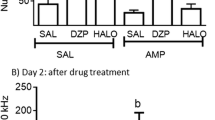Abstract
Two experiments were performed with adult male rats of the Long-Evans strain to determine the specificity of fluprizine hydrochloride in decreasing offensive attack. Both 4 and 8 mg/kg doses (IP) significantly reduced offense by resident males selected for high or medium levels of aggression when tested with intruders 30 min postinjection. No reliable differences in other social or nonsocial behaviors were observed. Drug treatment resulted in an overall reduction in offensive behavior of more than 70% in both groups. Actual biting and wounding of intruders by treated subjects was decreased by as much as 98%. A second experiment assessed the drug's influence on defense in the “shockelicited aggression” paradigm. While duration of boxing to multiple intermittent shocks was significantly suppressed by drug administration (4 and 8 mg/kg), the same doses had no effect on postshock duration of boxing, or sonic and ultrasonic vocalizations following several high intensity (1.5 mA) shocks. These findings are consistent with other research on this and related phenylpiperazine compounds, indicating that its action is specific in reducing offense with minimal influence on social or defensive behavior.
Similar content being viewed by others
References
Adams DB (1979) Inborn and acquired aspects of offense and defense motivational systems in muroid rodents: Role of memory. In: Oniani T (ed) Neurobiological bases of memory. Metsniereba, Tbilisi, USSR, pp 149–160
Blanchard DC, Blanchard RJ (1984) Affect and aggression: An animal model applied to human behavior. In: Blanchard RJ, Blanchard DC (eds) Advances in the study of aggression, vol 1. Academic, New York, pp 1–62
Blanchard DC, Blanchard RJ, Lee EMC, Nakamura S (1979) Defensive behaviors in rats following septal and septal-amygdala lesions. J Comp Physiol Psychol 93:378–390
Blanchard RJ, Blanchard DC (1977) Aggressive behavior in the rat. Behav Biol 21:197–224
Blanchard RJ, Blanchard DC (1981) The organization and modeling of aggression. In: Brain PF, Benton D (eds) The biology of aggression. Sijhoff and Noordhoff, Alphen aan der Rijn, pp 529–562
Brain PF, Poole AE (1976) The role of endocrines in isolation-induced intermale fighting in albino laboratory mice. II. Sex steroid influences in aggressive mice. Aggressive Behav 2:55–76
Flannelly KJ, Blanchard RJ, Muraoka MY, Flannelly L (1982) Copulation increases offensive attack in male rats. Physiol Behav 29:381–385
Flannelly KJ, Flannelly L, Blanchard RJ (1984) Adult experience and the expression of aggression: A comparative analysis. In: Flannelly KJ, Blanchard RJ, Blanchard DC (eds) Biological perspectives on aggression. Alan R. Liss, New York, pp 207–259
Grant EC, Mackintosh JJ (1963) A comparison of the social postures of some common laboratory rodents. Behaviour 21:246–259
Koolhaas JM, Schuurman T, Wiepkema PR (1980) The organization of intraspecific agonistic behaviour in the rat. Prog Neurobiol 15:247–268
Mackintosh JH, Chance MRA, Silverman AP (1977) The contribution of ethological techniques to the study of drug effects. In: Iversen LL, Iversen SD, Snyder SH (eds) Handbook of psychopharmacology. Plenum, New York, pp 3–35
Miczek KA (1979) A new test for aggression in rats without aversive stimulation: Differential effects of d-amphetamine and cocaine. Psychopharmacology, 60:253–259
Miczek KA, Krsiak M (1979) Drug effects on agonistic behavior. In: Thompson T, Dews PB (eds) Advances in behavioral pharmacology. Academic, New York, pp 87–162
Olivier B (1981) Selective anti-aggressive properties of DU27725: Ethological analyses of intermale and territorial aggression in the male rat. Pharmacol Biochem Behav 14:61–77
Olivier B, Mos J, van der Poel AM, Krijzer FNC, Kruk MR (1984) Effects of a new psychoactive drug (DU27716) on different models of rat agonistic behaviour and EEG. In: Flannelly KJ, Blanchard RJ, Blanchard DC (eds) Biological perspectives on aggression. Alan R Liss, New York, pp 261–279
Racine MA (1982) The effects of DU27716 on aggressive behavior in albino mice. Unpublished MA thesis, Department of Psychology, University of Hawaii
Racine MA, Flannelly KJ, Blanchard DC (1984) Anti-aggressive effects of DU27716 on attack and defentive behavior in the albino mouse. In: Flannelly KJ, Blanchard RJ, Blanchard DC (eds) Biological perspectives on aggression. Alan R Liss, New York, pp 281–293
Rodgers RJ, Hendrie CA (1982) Agonistic behaviour in rats: Evidence for non-involvement of opioid mechanisms. Physiol Behav 29:85–90
Sales GD (1972) Ultrasound and agressive behaviour in rats and other small mammals. Anim Behav 20:88–100
Author information
Authors and Affiliations
Rights and permissions
About this article
Cite this article
Flannelly, K.J., Muraoka, M.Y., Blachard, D.C. et al. Specific anti-aggressive effects of fluprazine hydrochloride. Psychopharmacology 87, 86–89 (1985). https://doi.org/10.1007/BF00431784
Received:
Accepted:
Issue Date:
DOI: https://doi.org/10.1007/BF00431784



